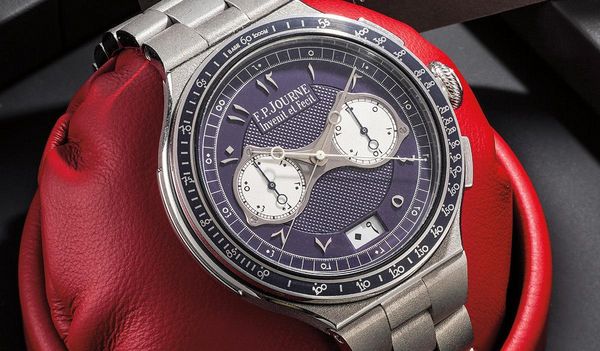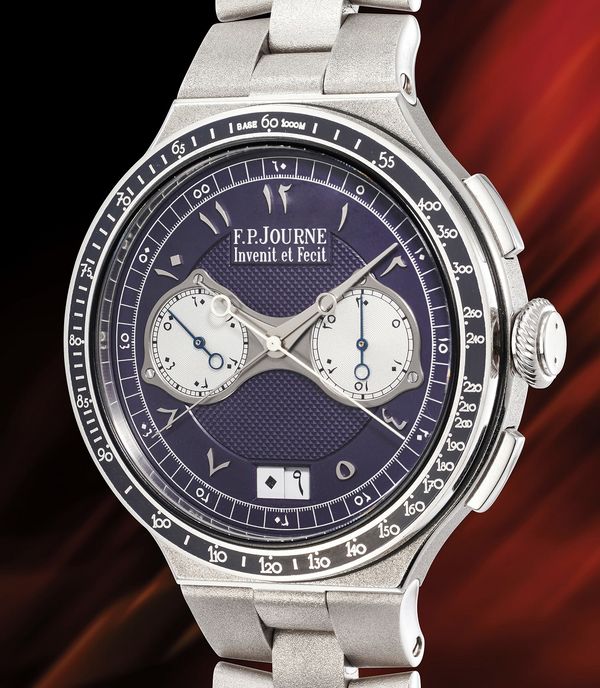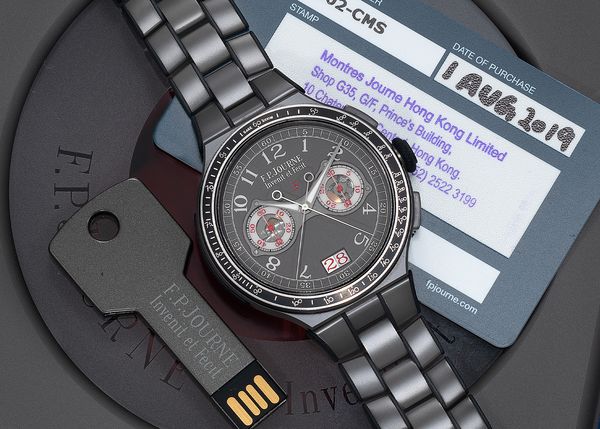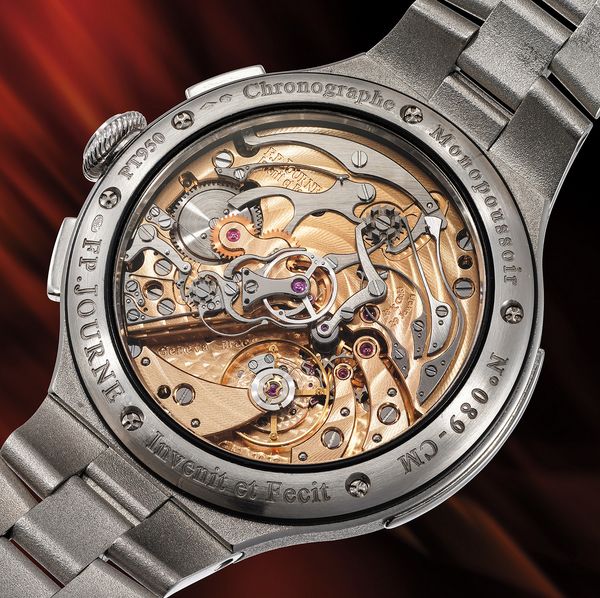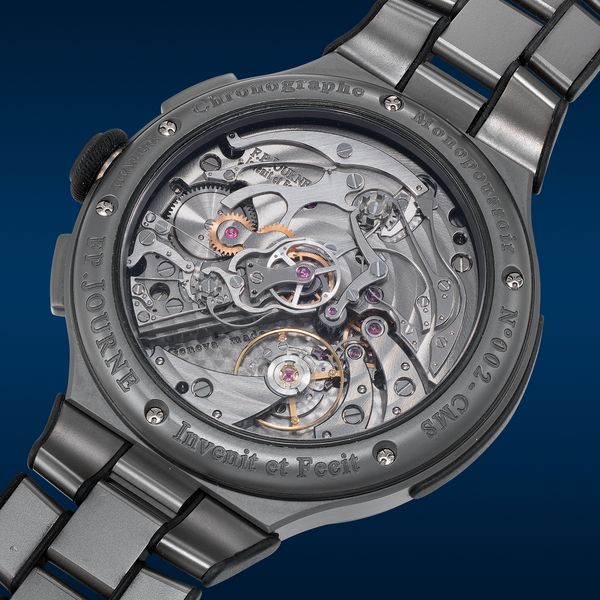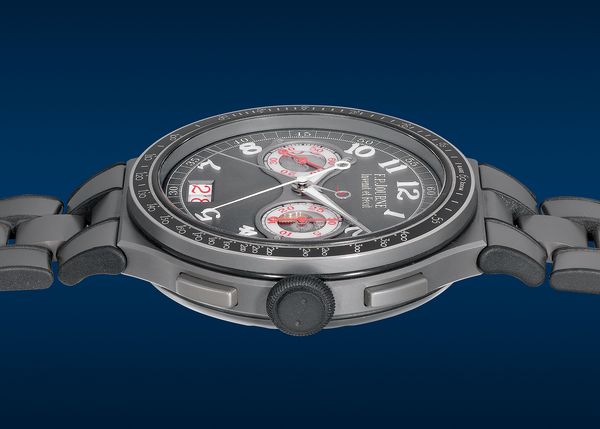Our first live auction of 2024, the PHILLIPS Geneva Watch Auction: XIX, takes place on May 11 and 12, at the Hotel President, at Quai Wilson 47 in central Geneva. The auction includes more than 215 of the world's finest watches – and though we are loath to boast, we truly think it's one of the best catalogs we've ever put together. We'll be highlighting a number of the most interesting lots and stories featured in the sale over the next month, including the platinum F.P. Journe LineSport Chronographe Monopoussoir Rattrapante (lot 62) featured in this article.
– Logan Baker
What watch do you think of first when it comes to F.P. Journe?
Longtime classics such as the Chronomètre à Résonance, the Tourbillon Souverain, or the Chronomètre Bleu might be your answer. Or you might favor halo products such as the Sonnerie Souverain, the Astronomic, and the Centigraphe. A watch you might not think of, at least in your initial guesses, however, is the Chronographe Monopoussoir Rattrapante, Journe’s split-second chronograph that was first revealed four years ago, in 2018.
A traditional split-seconds chronograph is a true high watermark for any watchmaker, big or small. It’s rarefied terrain that separates the wheat from the chaff, at least in the world of high-end luxury watch collecting. Patek Philippe, A. Lange & Söhne, and Vacheron Constantin are all well-known for their rattrapante references, but it’s a complication F.P. Journe had yet to tackle until the late 2010s.
F.P. Journe’s very first split-seconds experiment came at the Only Watch Charity Auction in November 2017, when a unique piece Chronographe Monopoussoir Rattrapante sold for more than one million Swiss Francs. A few months later, a production version of the watch would officially launch as part of Journe’s LineSport collection, in either a titanium, pink gold, or platinum case. The movements used in the platinum and pink gold examples were created using Journe’s traditional pink gold construction, while the movement in the titanium example was built using an unusual material for watchmaking: aluminum.
The split-seconds chronograph is one of the most challenging and fascinating complications to develop and execute, and it’s always fascinating to examine a new contender in the segment. The Chronographe Monopoussoir Rattrapante is no longer a “new” watch, but it is a fascinating one that is surprisingly not discussed as frequently as some of the industry’s more well-known contemporary split-seconds chronographs, such as the Patek 5370P or the A. Lange & Söhne Double Split and Triple Split.
And that’s a shame. The Chronographe Monopoussoir Rattrapante has a lot to offer any serious watch collector that’s interested in the mechanics behind a split-seconds chronograph but desires it in a wearable and sporty package. The only other watches to combine a rattrapante complication with an integrated bracelet that I can think of are a small number of Royal Oak Concept and Grand Complication pieces, as well as the Czapek Antarctique Rattrapante that was released last year as a limited edition. The Journe predates the Czapek by a number of years, of course, and all of the Royal Oak models with rattrapante mechanisms include multiple other complications as well. The Chronographe Monopoussoir Rattrapante is also the thinnest (12mm, about the same height as a current-gen Rolex Daytona) of those models, and in the titanium configuration, it's easily the lightest.
As part of the LineSport collection, the Chronographe Monopoussoir Rattrapante does not look like a typical Journe timepiece. The case design is aggressive and wide (44mm diameter), and rubber inserts are placed on the caseband, crown, and bracelet to increase shock resistance. There’s also a thin bezel with a ceramic insert and tachymeter scale present.
The dial has a slightly more traditional appearance for Journe and comes from Les Cadraniers de Genève, the dial factory he owns in Meyrin, on the outskirts of Geneva. While the platinum and pink gold models have gold dials, the dial on the titanium example is made out of an aluminum alloy in an anthracite shade with applied luminous Arabic numerals, bright red accents, a big date display, traditional Journe hands, as well as a pair of transparent sapphire discs in the center of the two sub-dials, allowing a slight glimpse at the caliber 1518 inside.
The manual-wind, monopusher caliber 1518 is the main event, and we’ll focus the rest of this story on the unexpected aluminum variation found in the blasted-titanium Chronographe Monopoussoir Rattrapante. It’s the most interesting, the most affordable, and is also the first example to appear in a PHILLIPS auction, included inside the upc
Aluminum, used on the titanium example, is a soft and malleable metal that doesn’t often see use in high-end watchmaking, but F.P. Journe and his team have done an admirable job of dressing the caliber 1518 up with an identical approach to decoration as what you’d find in one of his pink gold movements. You can easily identify perlage on the baseplate, polished screw heads with chamfered slots, circular stripes on the bridges, and straight-graining on the few steel components (mostly the chronograph levers, plus the rattrapante clamps and wheels).
While the finish is executed in an overall satisfactory fashion, with a mixture of hand and machine finishing, the result does appear a bit on the “dull” side due to the aluminum material (below), especially compared to the warmth of the standard pink gold movement (above). It's an understandable and worthwhile exchange, as the tremendous lightness of the watch is hugely beneficial for a sport watch – plus, F.P. Journe has never been especially known for his movement decoration, either.
The movement is surprisingly wide at 33.60 mm in diameter, fitting snugly inside the 44mm case, as well as allowing for plenty of extra breathing space for the 285 total components and an extremely impressive thinness of 6.8mm. Given the extra-slim movement height, the levers, bridges, and plates are all especially flat with a miniscule amount of tolerance and space between each layer. The big date mechanism is a surprising inclusion, given the two separate date wheels required to show the large display likely take up significant room inside the movement.
Another benefit of the large diameter is the application of a large mainspring, enabling an impressive running autonomy of 80 hours, in addition to powering the chronograph and split-seconds mechanism. Fun fact: you can reach the full power reserve of the caliber 1518 with just 38 turns of the crown. The balance wheel, meanwhile, is also on the large side and features a variable inertia, free sprung design that beats at 3 Hz and offers fine adjustment capabilities and a high degree of shock resistance.
Two separate column wheels are employed to control the stop-start-split-reset of the chronograph mechanism, an arrangement that is typical of split-seconds chronographs. The column wheels each have six trapezoidal pillars and are on the small side, which makes the precision machining and finishing process involved in their creation even more difficult. The chronograph itself is a monopusher design, with the stop-start-reset function entirely controlled by the pusher at two o’clock on the caseband, while the split function can be actuated through the four o’clock pusher.
The chronograph starts, stops, and splits with excellent precision and zero shuttering action, partially thanks to the use of an oscillating pinion that remains in constant contact with the gear train, rather than a lateral clutch. Visible in the very center of the movement, the design of the split-seconds mechanism is not out of the ordinary. Engaging the four o’clock pusher triggers the secondary column wheel, pushing in the rattrapante clamps that grab and pause the spinning rattrapante wheel. As soon as the clamps have closed on the wheel, the seconds split on the dial side, with the grey split hand pausing in its tracks and the white chronograph seconds hand continuing its journey around the dial.
One element that some collectors might notice is missing in the rattrapante mechanism is an isolating device that would reduce the friction that builds up when the split-seconds wheel has been stopped, by momentarily disengaging the split-seconds wheel from the primary chronograph wheel and cam. It’s a common feature in high-end contemporary split-seconds chronographs, although many other models, including the A. Lange & Söhne 1815 Rattrapante, do not include it. The main drawback of an isolating mechanism is that it adds thickness to the movement, which is likely why Journe opted to proceed without. Instead, Journe included a jewel roller on the rattrapante lever that touches the heart-shaped cam, reducing the total resistance felt between the two wheels when the rattrapante is engaged.
The caliber 1518 is an evolution of the movement Journe used in the initial Only Watch unique piece. The original movement was the caliber 1517 and featured horizontal chronograph coupling rather than the oscillating pinion approach found in the production models. The chronograph levers also had to be redesigned from the caliber 1517 to the caliber 1518 to better function with the oscillating pinion. Many of the bridges were also slightly adjusted in their shape, size, and position, and as the big date complication was added, the crown wheel had to increase in size to incorporate a setting mechanism.
The caliber 1518 could then, interestingly enough, be considered an improved variant of the caliber 1517. Outside the quality of the decoration on the original movement, which involved extensive black polishing on the levers and springs, the caliber 1518 is both more complicated and the action of the chronograph has been improved. It’s the rare occasion where a production watch is an actual upgrade from the ultra-rare unique piece example.
The F.P. Journe Line Sport Chronographe Monopoussoir Rattrapante is full of surprises. It doesn’t look like many other split-seconds chronographs out there; in fact, it barely looks like a typical F.P. Journe creation at all. But there’s still a lot to appreciate about it, from the unconventional materials to the impressive technical attributes and high degree of wearability. It’s a rattrapante that can handle the bumps and bruises of daily life without a sweat.
It also presents a relatively excellent value for both a high-end split-seconds chronograph and a complicated F.P. Journe watch. The current MSRP for the titanium model is CHF 68,100 (pink gold, CHF 86,000; platinum, CHF 116,600), while you’ll easily be pushing into the six-figure ballpark for any comparable split-seconds chronograph from Patek Philippe, A. Lange & Söhne, or Vacheron Constantin. Very few examples of the watch in any metal have filtered out to the secondary market since the watch’s release, something that is fairly surprising, given the amount of interest in F.P. Journe these days. I noticed one example of the titanium model that recently sold through an online auction platform for USD $93,500, while the example featured in our current Hong Kong online auction has an estimate of HKD $320,000 - $630,000, or approximately USD $40,000 - $80,000.
As for the long-term trajectory of the model, it’s been reported that F.P. Journe has no plans to extend the caliber 1518 to any other collection in the future, so it looks like the Line Sport family will be the only place to experience his take on one of watchmaking’s most desirable complications for the time being – that is, if you can even find one.
Not only are they few and far between on the secondary market, but I recently spoke with an Authorized Retailer of F.P. Journe timepieces from a major European city who mentioned that they receive very few examples of the Chronographe Monopoussoir Rattrapante each year.
It goes without saying that they’re always quickly claimed in advance.
You can learn more, place a bid, and view the entire Phillips Geneva Watch Auction: XIX catalog here.
About Phillips In Association With Bacs & Russo
The team of specialists at PHILLIPS Watches is dedicated to an uncompromised approach to quality, transparency, and client service. Phillips in Association with Bacs & Russo holds the world record for the most successful watch auction, with its Geneva Watch Auction: XIV having realized $74.5 million in 2021. Over the course of 2021 and 2022, the company sold 100% of the watches offered, a first in the industry, resulting in the highest annual total in history across all the auction houses at $227 million.
About Logan Baker
Logan has spent the past decade reporting on every aspect of the watch business. He joined Phillips in Association with Bacs & Russo at the start of 2023 as the department's Senior Editorial Manager. He splits his time between New York and Geneva.
Recommended Reading
A Beginner’s Guide To The World Of F.P. Journe
François-Paul Journe Shares Personal Stories Behind His Creations
A Round-Up Of The Greatest F.P. Journe Watches Sold At Phillips (So Far!)
